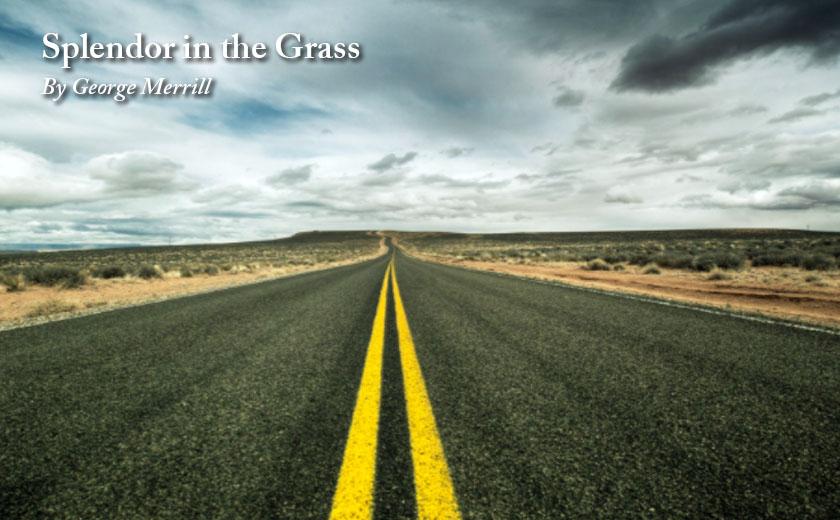A few months ago, a nearby road had been freshly resurfaced. I didn’t see a rut or pothole anywhere and the surface was as shiny as coal. A yellow centerline illuminated by the earlysun snaked along the winding road while the roadsides were framed by crisp white shoulder stripes. It was new, neat, gleaming and as lifeless as plastic.
At the edges of the road, I saw signs of life. Black shards of macadam had risen here and there in small mounds, like black anthills. Where the macadam had covered over them over, tiny grass blades and plant stems pierced through the thick tar to the surface, bursting the macadam like budding flowers. The grass hadn’t buckled under the tons of asphalt heaped upon it; in a quiet way, the grass affirmed life.
As a boy I mowed our lawn. I used an old push mower to cut the grass. I grumbled about doing it. Still I liked the aroma of freshly cut grass.
Poets like William Wordsworth remembers with melancholy fondness “ . . . the hour of splendour in the grass,” as Dylan Thomas recalls being “happy as the grass is green.” Walt Whitman thought that a single blade of grass “ . . . is no less than a journey work of the stars.” Grass is indeed a survivor; cut to the quick, grass soon grows back again.
Grass is the fourth largest plant family in the world. Its twenty four-million-year survival can be attributed, not to taking over, but to the symbioses grass sets up with every other living creature: what’s sometimes called the survival of the cooperative. It’s incredibly pliable, both giving and taking. With its almost nine thousand species, grass is a creature of mutuality, feeding most living things on the earth, above the water and below it. It’s the lifeblood of countless critters, among them ourselves. The Chesapeake Bay depends on grasses. Grass asks for little; some water and a little space.
Space is the problem. Unlike grass, humans dominate space, crowding out each other and other living things as well. A macadam-aproned shopping mall inters everything below it – and frequently around it – in an asphalt coffin. If I were to walk the width and breadth of a parking lot in bare feet, my feet would never once touch the earth; much less the grass and the soles of my feet would be slashed to pieces by broken glass. My soul would also feel cut.
Asphalt and concrete alienate us from our earth. We rarely have our feet on the ground. They’re often several times removed. The connection to our roots is lost, the green arteries of fields and meadows that lift our hearts are severed by overdevelopment. Concrete and asphalt harden landscapes like plaque hardens arteries. As acre upon acre of asphalt and concrete shopping centers cover the earth’s living tissue, land is asphyxiated. I’ve never read any poem nor heard an elegy about a concrete apron or an asphalt strip mall that stirred the heart, except perhaps obliquely, in the laments of the jilted lovers of country music who hit the lonesome road.
But increasingly, people flee overdeveloped places and congested roads–if they can afford to– and come to Easton, Cambridge or St. Michaels, or Crapo. They’re seeking a geographic cure here on the shore, a kind of spiritual angioplasty, and a release from the unhealthy psychic and physical clutter we’ve created by our suburban developments. It’s odd that some would want to recapitulate here by encouraging new mall strips, the very overdevelopment that they were fleeing in the suburbs. Our insatiable appetites insist on having the riches of both kingdoms and in so doing vanquish the countryside we say we long for. It’s like surviving a heart attack and then celebrating it with a cigarette and a Big Mac.
The Shoreline of the Chesapeake offers a unique heritage. We see it in our open fields, in the water and in our fragile marshlands. These natural endowments have been conducive to gracious living. I would hate to see us do what one Baltimore contractor urges us to do and writes it on all his trucks: “ Cover It with Asphalt.”
For the spirit and for the belly, however, grass, like trees, has proved to be one of nature’s most generous providers and hardiest survivors. A mall the size of the Delmarva Peninsula could never feed as many people as a comparable wheat field. The mall’s runoff would be toxic to grasses. The refuse would be suffocating. And it certainly wouldn’t feed the soul; in shopping centers I may see a few cement planters but they are filled with limp decorative plants, like those in hotel lobbies, mostly filled with cigarette butts, plastic bottles and sale fliers.
The evolutionary process has a way of making mid course corrections. As we move our trade from big boxes and malls to direct mail through the Internet, perhaps we’ll see more and more malls deserted. And as the decaying concrete and asphalt dries and crumbles, what will emerge around the abandoned big boxes and broken fissures will be fresh new blades of grass.



Write a Letter to the Editor on this Article
We encourage readers to offer their point of view on this article by submitting the following form. Editing is sometimes necessary and is done at the discretion of the editorial staff.